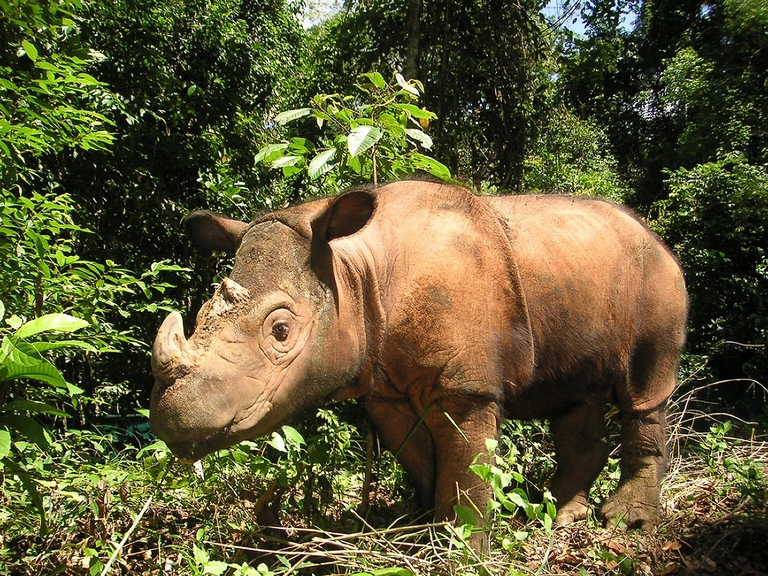
The Amazon became an alternative classroom during the pandemic. Now, the educational forest in Batraja, Bolivia, lives on to teach children and adults the value of nature.
The Sumatran rhino (Dicerorhinus sumatrensis), hasn’t been sighted in the area of Eastern Kalimantan, Indonesian Borneo, for over 40 years. Its origins date back to the prehistoric era, descending from the megafauna that roamed the planet thousands of years ago. The sighting of the Sumatran rhino Until 2013, the animal was thought to be extinct in this
The Sumatran rhino (Dicerorhinus sumatrensis), hasn’t been sighted in the area of Eastern Kalimantan, Indonesian Borneo, for over 40 years. Its origins date back to the prehistoric era, descending from the megafauna that roamed the planet thousands of years ago.
Until 2013, the animal was thought to be extinct in this area. However, three years ago, photo traps recorded an individual while cooling down in a puddle of mud and disappearing again into the thick forest. Now there are no doubts left: on the 12th of March, a female Sumatran rhino was observed, 40 years after the last sighting.
The animal has been safely captured by WWF in a pit trap used to monitor wild species. “This is an exciting discovery and a major conservation success,” said Doctor Efransjah, CEO of WWF Indonesia. “We now have proof that a species once thought extinct in Kalimantan still roams the forests, and we will strengthen our efforts to protect this extraordinary species.”
The female Sumatran rhino, which is estimated to be between four and five years old, won’t continue roaming the forests of Kalimantan: it will be brought to a protected natural reserve in Borneo, about 150 kilometres away, in order to grant its safety and reduce poaching risks.
WWF Indonesia aims to establish a new sanctuary for Sumatran rhinos in Indonesia, as three more individuals are to be brought to the protected area soon, in hopes of starting a thriving, more stable population. It is estimated that there are only 100 Sumatran rhinos left in the wild, as the population has been wiped out by poaching and habitat loss due to deforestation and mining.
Last year, the eastern Sumatran rhinoceros, also known as the Bornean rhinoceros (Dicerorhinus sumatrensis harrissoni), a subspecies of the Sumatran rhino, was declared extinct in the wild in the Malaysian state of Sabah. According to collected data, scientists assume there are about 15 rhinos, divided into 3 populations, in the Kalimantan area.
“Given the dire situation of Sumatran rhinos in the wild, it is crucial that isolated individuals such as this female become part of a managed breeding population to ensure the future of the species,” said Nilanga Jayasinghe, WWF wildlife conservation expert.
A few hundreds of individuals are kept in zoos all over the world, but these animals rarely reproduce in captivity. We hope that the female Sumatran rhino captured by the WWF will help save the species and that meeting a Sumatran rhino roaming wild in the forest will no longer be considered a once-every-40-years event.
Siamo anche su WhatsApp. Segui il canale ufficiale LifeGate per restare aggiornata, aggiornato sulle ultime notizie e sulle nostre attività.
![]()
Quest'opera è distribuita con Licenza Creative Commons Attribuzione - Non commerciale - Non opere derivate 4.0 Internazionale.
The Amazon became an alternative classroom during the pandemic. Now, the educational forest in Batraja, Bolivia, lives on to teach children and adults the value of nature.
Our species took its first steps in a world covered in trees. Today, forests offer us sustenance, shelter, and clean the air that we breathe.
Bangladesh suffered widespread damage as a result of Cyclone Amphan. Yet the Sundarbans mangrove forest acted as a natural barrier protecting the country from further destruction, as it has done countless times before.
On top of a 2.4 million dollar compensation, the indigenous Ashaninka people will receive an official apology from the companies who deforested their lands in the 1980s.
The tapir was reintroduced into Brazil’s Atlantic Forest, the country’s most at-risk ecosystem. The species can play a key role in the forest’s recovery.
Forests are home to 80 per cent of the world’s terrestrial biodiversity. This year’s International Day of Forests highlights the urgent changes needed to save them.
After a legal battle that lasted two years, Indonesia’s Supreme Court has revoked the permit to mine for coal in the forests of South Kalimantan in Borneo.
The list of human and animal victims of the Australia wildfires keeps growing – one species might already have gone extinct – as the smoke even reaches South America.
Areas where the FARC guerrilla used to hold power in Colombia have faced record deforestation. Farmers cut down trees, burn land and plant grass for cows. Because, “what else can we do for a living here in the Colombian Amazon”? An intimate report from the heart of the felled forest in Caquetá.









